-
 A Novel Railgun-Based Actuation System for Ultrafast DC Circuit Breakers in EV Fast-Charging Applications
A Novel Railgun-Based Actuation System for Ultrafast DC Circuit Breakers in EV Fast-Charging Applications -
 The Impact of Weight Distribution in Heavy Battery Electric Vehicles on Pavement Performance: A Preliminary Study
The Impact of Weight Distribution in Heavy Battery Electric Vehicles on Pavement Performance: A Preliminary Study -
 Equity Considerations in Public Electric Vehicle Charging: A Review
Equity Considerations in Public Electric Vehicle Charging: A Review -
 Efficient Drone Data Collection in WSNs: ILP and mTSP Integration with Quality Assessment
Efficient Drone Data Collection in WSNs: ILP and mTSP Integration with Quality Assessment -
 Enhancing Thermal Comfort and Efficiency in Fuel Cell Trucks: A Predictive Control Approach for Cabin Heating
Enhancing Thermal Comfort and Efficiency in Fuel Cell Trucks: A Predictive Control Approach for Cabin Heating
Journal Description
World Electric Vehicle Journal
World Electric Vehicle Journal
is the first peer-reviewed, international, scientific journal that comprehensively covers all studies related to battery, hybrid, and fuel cell electric vehicles. The journal is owned by the World Electric Vehicle Association (WEVA) and its members, the E-Mobility Europe, Electric Drive Transportation Association (EDTA), and Electric Vehicle Association of Asia Pacific (EVAAP). It has been published monthly online by MDPI since Volume 9, Issue 1 (2018).
- Open Access— free for readers, with article processing charges (APC) paid by authors or their institutions.
- High Visibility: indexed within Scopus, ESCI (Web of Science), Ei Compendex, and other databases.
- Journal Rank: JCR - Q2 (Engineering, Electrical and Electronic) / CiteScore - Q2 (Automotive Engineering)
- Rapid Publication: manuscripts are peer-reviewed and a first decision is provided to authors approximately 17.6 days after submission; acceptance to publication is undertaken in 2.9 days (median values for papers published in this journal in the first half of 2025).
- Recognition of Reviewers: reviewers who provide timely, thorough peer-review reports receive vouchers entitling them to a discount on the APC of their next publication in any MDPI journal, in appreciation of the work done.
Impact Factor:
2.6 (2024)
Latest Articles
Enhanced Sliding-Mode Observer for Mechanical Parameter Estimation and Load Compensation in PMSM Drives
World Electr. Veh. J. 2025, 16(11), 629; https://doi.org/10.3390/wevj16110629 (registering DOI) - 18 Nov 2025
Abstract
This paper presents an improved sliding-mode observer (SMO) for estimating mechanical parameters and compensating load torque in permanent magnet synchronous motor (PMSM) drives. Traditional SMOs have limited robustness when the motor model is inaccurate. To solve this, an enhanced sliding-mode observer (ESMO) is
[...] Read more.
This paper presents an improved sliding-mode observer (SMO) for estimating mechanical parameters and compensating load torque in permanent magnet synchronous motor (PMSM) drives. Traditional SMOs have limited robustness when the motor model is inaccurate. To solve this, an enhanced sliding-mode observer (ESMO) is proposed. It can estimate both the total inertia and the load torque at the same time. The method is verified using Lyapunov stability analysis and convergence time calculation. Experimental results show that, when combined with a single-vector Model Predictive Current Control (MPCC), the proposed ESMO achieves zero overshoot during no-load startup and keeps the steady-state error below 0.1% under load changes. It also reduces q-axis current ripple and improves harmonic suppression. This control method is suitable for applications that require high precision and strong robustness, such as robots, electric vehicles, and smart manufacturing.
Full article
(This article belongs to the Section Propulsion Systems and Components)
►
Show Figures
Open AccessArticle
Expanding Electric and Vehicle-Based Solar Transit Options with Breakthrough Vehicular Efficiencies
by
Adam B. Suppes and Galen Suppes
World Electr. Veh. J. 2025, 16(11), 628; https://doi.org/10.3390/wevj16110628 (registering DOI) - 18 Nov 2025
Abstract
Traditional approaches to overcoming energy loss from resistances of vehicular transit velocities have focused primarily on reducing aerodynamic drag through streamlining air flow. These approaches have overlooked significant reductions in resistance on highways by reducing rolling losses and the aerodynamic drag associated with
[...] Read more.
Traditional approaches to overcoming energy loss from resistances of vehicular transit velocities have focused primarily on reducing aerodynamic drag through streamlining air flow. These approaches have overlooked significant reductions in resistance on highways by reducing rolling losses and the aerodynamic drag associated with boundary layer separation and leading-edge stagnation regions. Ground effect vehicles are able to make significant strides towards reducing these two resistances. These vehicles can approach an 80% reduction in resistance compared to conventional frame streamlining alone. These substantial reductions to resistance enable a more effective and broader range of electric vehicles, including electric trucks and railcars. Lower resistance enables higher speeds at the same power consumption. Examples of digital prototype performances include up to 50% and 30% reductions in resistance through mitigating rolling/drivetrain and boundary layer separation losses, respectively. Digital prototypes are able to reach a lift-to-drag efficiency of 25 while maintaining a 0.2 aspect ratio. A cascade of additional advantages arises from aerodynamic lift-enabling rubber tires on steel rails for multimodal and widespread service. This paper details the mechanisms of how to achieve substantial reductions in energy consumption and enable transit transformations. The technology enables open-ended evolution with far greater possibilities than current transit options. The technological evolution includes electric automobiles, delivery trucks, semi-trucks, and railcars using batteries and solar sheets with significant competitive advantages over fossil fuels.
Full article
(This article belongs to the Special Issue The Contribution of Electric Vehicles to Realization of Dual Carbon Goal)
►▼
Show Figures
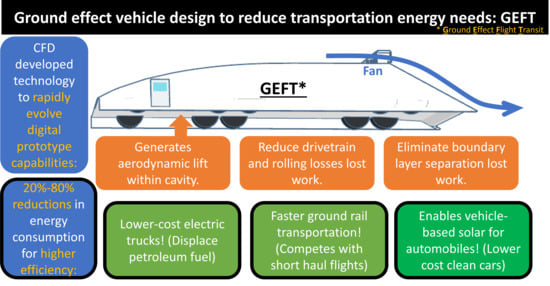
Graphical abstract
Open AccessArticle
Electric Bus Depot Charging in South Africa: Lessons for Grid Integration
by
Praise George-Kayode, Halloran Stratford and Marthinus Johannes Booysen
World Electr. Veh. J. 2025, 16(11), 627; https://doi.org/10.3390/wevj16110627 (registering DOI) - 18 Nov 2025
Abstract
Uncontrolled charging of large electric bus fleets can strain constrained power grids, such as South Africa’s. This study develops and evaluates a demand-oriented charging strategy for Golden Arrow Bus Services using a Mixed-Integer Linear Programming (MILP) model calibrated with real operating data. The
[...] Read more.
Uncontrolled charging of large electric bus fleets can strain constrained power grids, such as South Africa’s. This study develops and evaluates a demand-oriented charging strategy for Golden Arrow Bus Services using a Mixed-Integer Linear Programming (MILP) model calibrated with real operating data. The model schedules fleet charging over an off-peak window to minimise the highest total demand charge (Notified Maximum Demand, NMD) while respecting arrival state of charge (SOC), Time-of-Use (ToU) tariffs, and ensuring all vehicles are fully charged before dispatch. Compared to the unmanaged baseline, the optimised schedules reduce the peak demand charge by 17%, keeping total depot demand below 1 MW and ensuring full fleet readiness. The strategy also eliminates all energy consumption during expensive peak-tariff windows in both winter and summer. Further analysis shows that raising the minimum arrival SOC reduces the required optimum per-bus demand approximately linearly (≈1.5 kW per +5% SOC), whereas widening the SOC arrival range increases demand variability. This MILP framework demonstrates that exploiting SOC diversity and modest charge capacity capping can significantly lower peak demand and operational costs, offering a validated model for depots in other capacity-constrained power systems.
Full article
(This article belongs to the Special Issue Smart Charging Strategies for Plug-In Electric Vehicles)
►▼
Show Figures
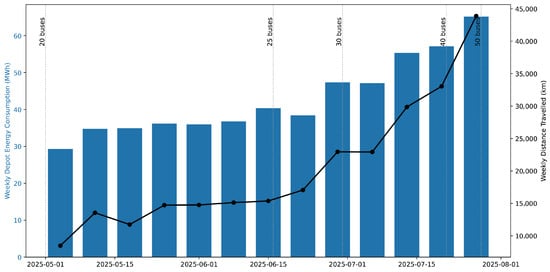
Figure 1
Open AccessArticle
Research on Real-Time Operational Risk Prediction for New Energy Vehicles Based on Multi-Source Feature Fusion
by
Yilong Shi, Shubing Huang, Beichen Zhao, Liang Peng and Chongming Wang
World Electr. Veh. J. 2025, 16(11), 626; https://doi.org/10.3390/wevj16110626 (registering DOI) - 18 Nov 2025
Abstract
With the rapid growth of new energy vehicles (NEVs), the number of NEV-related traffic accidents has risen sharply. To address the challenge of low accuracy in real-time risk assessment caused by the coupling of multi-source heterogeneous data, this paper proposes a real-time risk
[...] Read more.
With the rapid growth of new energy vehicles (NEVs), the number of NEV-related traffic accidents has risen sharply. To address the challenge of low accuracy in real-time risk assessment caused by the coupling of multi-source heterogeneous data, this paper proposes a real-time risk prediction method for NEV operations based on multi-source feature fusion. First, considering issues such as signal loss and bias in NEV operation data and accident records, a fused accident operation dataset is constructed through data matching, imputation, and Kalman smoothing. Then, this study analyzes the influence of external factors (e.g., weather, road type, and lighting) and internal factors (e.g., speed, acceleration, and driving duration) on accident risk and develops a normalized representation method for NEV accident risk features. Based on the coupling of internal and external parameters, a real-time accident risk prediction model is established based on the XGBoost algorithm, enabling accurate prediction of NEV accidents. Vehicle data tests show that the proposed method achieves an average accident risk prediction accuracy of 69.60%, outperforming the traditional Analytic Hierarchy Process and Support Vector Machine models. Finally, application effect demonstrates that the method reduces the NEV accident rate to 0.83%, effectively assisting traffic management departments in identifying and warning high-risk vehicles, thereby improving road traffic safety.
Full article
(This article belongs to the Section Vehicle and Transportation Systems)
►▼
Show Figures
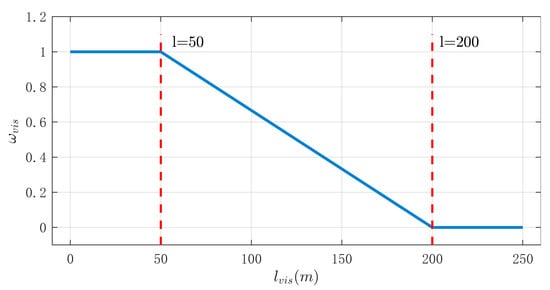
Figure 1
Open AccessArticle
Research on the Recycling Strategy of End-of-Life Power Battery for Electric Vehicles Based on Evolutionary Game
by
Fangfang Zhao, Yiqi Geng, Wenhui Shi and Yingxue Ren
World Electr. Veh. J. 2025, 16(11), 625; https://doi.org/10.3390/wevj16110625 (registering DOI) - 17 Nov 2025
Abstract
The rapid growth of China’s electric vehicle (EV) market has led to a peak in end-of-life (EOL) power batteries, yet the recycling sector remains dominated by informal operations. This paper incorporates the formal and informal recycling participation behaviours of EV owners into the
[...] Read more.
The rapid growth of China’s electric vehicle (EV) market has led to a peak in end-of-life (EOL) power batteries, yet the recycling sector remains dominated by informal operations. This paper incorporates the formal and informal recycling participation behaviours of EV owners into the framework of evolutionary games, systematically examines the mechanism by which governmental incentive and disincentive mechanisms influence the evolutionary stability of each party, and constructs a tripartite evolutionary game model involving the government, recycling enterprises, and EV owners. Numerical simulation experiments conducted using PyCharm 2.3 provide an in-depth exploration of the strategic evolutionary trajectories of each participating agent. The findings indicate that (1) the stable strategy for the game-theoretic system of EOL power battery recycling is government non-regulation, recycling enterprises adopting formal recycling practices, and EV owners participating in formal recycling; (2) strengthening penalties against recycling enterprises will accelerate their transition towards formal recycling strategies, while increasing incentive levels can significantly enhance the steady-state probability of firms opting for formal recycling; (3) government subsidies for EV owners encourage both EV owners and recycling enterprises to adopt formal recycling, with recycling enterprises shifting first. This study enriches the application of evolutionary game theory in the field of EOL power battery recycling and further provides guidance for the healthy development of the recycling industry.
Full article
(This article belongs to the Section Energy Supply and Sustainability)
►▼
Show Figures
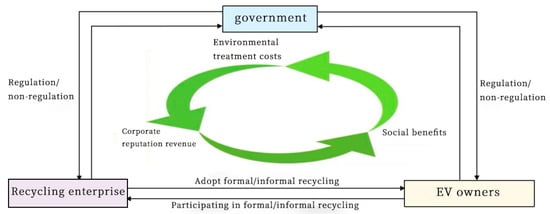
Figure 1
Open AccessArticle
Emission/Reliability-Aware Stochastic Optimization of Electric Bus Parking Lots and Renewable Energy Sources in Distribution Network: A Fuzzy Multi-Objective Framework Considering Forecasted Data
by
Masood ur Rehman, Ujwal Ramesh Shirode, Aarti Suryakant Pawar, Tze Jin Wong, Egambergan Khudaynazarov and Saber Arabi Nowdeh
World Electr. Veh. J. 2025, 16(11), 624; https://doi.org/10.3390/wevj16110624 (registering DOI) - 17 Nov 2025
Abstract
►▼
Show Figures
In this paper, an emission- and reliability-aware stochastic optimization model is proposed for the economic planning of electric bus parking lots (EBPLs) with photovoltaic (PV) and wind-turbine (WT) resources in an 85-bus radial distribution network. The model simultaneously minimizes operating, emission, and energy-loss
[...] Read more.
In this paper, an emission- and reliability-aware stochastic optimization model is proposed for the economic planning of electric bus parking lots (EBPLs) with photovoltaic (PV) and wind-turbine (WT) resources in an 85-bus radial distribution network. The model simultaneously minimizes operating, emission, and energy-loss costs while increasing system reliability, measured by energy not supplied (ENS), and uses a fuzzy decision-making approach to determine the final solution. To address optimization challenges, a new multi-objective entropy-guided Sinh–Cosh Optimizer (MO-ESCHO) is proposed to efficiently mitigate premature convergence and produce a well-distributed Pareto front. Also, a hybrid forecasting architecture that combines MO-ESCHO and artificial neural networks (ANN) is proposed for accurate prediction of PV and WT power and network loading. The framework is tested across five cases, progressively incorporating EBPL, demand response (DR), forecast information, and stochastic simulation of uncertainties using a new hybrid Unscented Transformation–Cubature Quadrature Rule (UT-CQR) method. Comparative analyses against conventional methods confirm superior performance in achieving better objective values and ensuring computational efficiency. The outcomes indicate that the combination of EBPL with RES reduces operating costs by 5.23%, emission costs by 27.39%, and ENS by 11.48% compared with the base case with RES alone. Moreover, incorporating the stochastic model increases operating costs by 6.03%, emission costs by 5.05%, and ENS by 7.94% over the deterministic forecast case, reflecting the added complexity of uncertainty. The main contributions lie in coupling EBPLs and RES under uncertainty and proposing UT-CQR, which exhibits robust system performance with reduced variance and lower computational effort compared with Monte Carlo and cloud-model approaches.
Full article
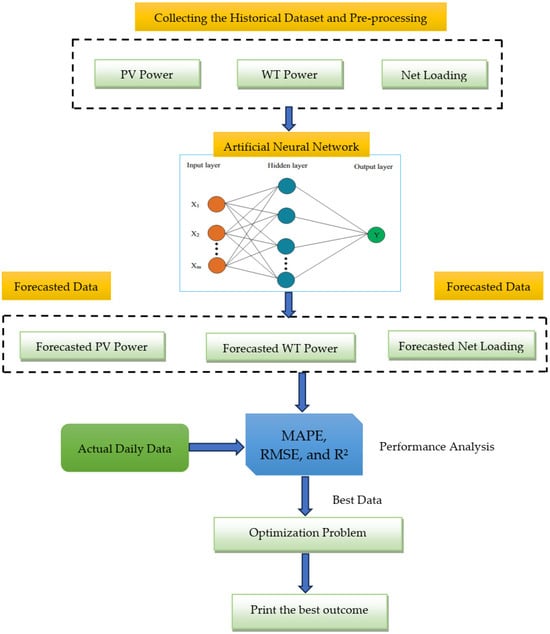
Figure 1
Open AccessArticle
Evaluating Unplug Incentives to Improve User Experience and Increase DC Fast Charger Utilization
by
Nathaniel Pearre, Niranjan Jayanath and Lukas Swan
World Electr. Veh. J. 2025, 16(11), 623; https://doi.org/10.3390/wevj16110623 (registering DOI) - 14 Nov 2025
Abstract
Direct current fast charging is a necessary element of the transition to electric vehicles (EVs). Regulatory complexity, capital requirements, and challenging business models hinder charging infrastructure deployment, so focusing on the efficient use of such infrastructure is of paramount importance. A tool to
[...] Read more.
Direct current fast charging is a necessary element of the transition to electric vehicles (EVs). Regulatory complexity, capital requirements, and challenging business models hinder charging infrastructure deployment, so focusing on the efficient use of such infrastructure is of paramount importance. A tool to improve this efficiency is an incentive to terminate charging events when charging power drops, the vehicle state of charge rises above some value, or time plugged in exceeds a threshold. A timeseries charging demand model was built based on observed EV population and charging behavior. This was used to explore these three incentive trigger metrics across a range of plausible values, to find their relative impacts on the vehicles charging, those waiting in line to access a cordset, and charging site operators. Results indicate that basing such a trigger on charging power would have little impact if the threshold power is low enough to accommodate older, slower-charging vehicles, but that more restrictive limits based on state of charge or charging duration can decrease wait times, increase vehicle throughput, and increase total energy sales for cordsets serving more than 1000 EVs per year.
Full article
(This article belongs to the Section Charging Infrastructure and Grid Integration)
►▼
Show Figures

Figure 1
Open AccessArticle
CLAMT Shifting Strategy with Dog Clutch and Active Synchronization for Electrified Tractors
by
Bertug Bingol, Ece Olcay Gunes and Murat Gundogdu
World Electr. Veh. J. 2025, 16(11), 622; https://doi.org/10.3390/wevj16110622 - 14 Nov 2025
Abstract
►▼
Show Figures
This study focuses on the development and optimization of a Clutchless Automated-Manual Transmission (CLAMT) system for tractors, aiming to enhance performance and efficiency across diverse operating conditions. It explores the use of a dog clutch mechanism as a simpler, robust alternative to traditional
[...] Read more.
This study focuses on the development and optimization of a Clutchless Automated-Manual Transmission (CLAMT) system for tractors, aiming to enhance performance and efficiency across diverse operating conditions. It explores the use of a dog clutch mechanism as a simpler, robust alternative to traditional synchronizers. The main objective is to replace complex transmission setups—often requiring up to 32 gear ratios—with a system that operates efficiently using only two gears, without sacrificing versatility. Smooth gear engagement, even under varying loads and terrains, is a key challenge addressed. To ensure this, a Vehicle Management Unit (VMU) manages gear shifts and actively synchronizes speeds. The system leverages steady torque delivery through control algorithms and modern hybrid/electric powertrain capabilities. Two algorithmic approaches are implemented, and their performance is evaluated through empirical testing. Results show improvements in system simplicity, transmission reliability, and overall operational efficiency. The proposed approach offers valuable insights for future agricultural drivetrains, highlighting the potential of dog clutch-based architectures in reducing mechanical complexity while maintaining functional performance.
Full article
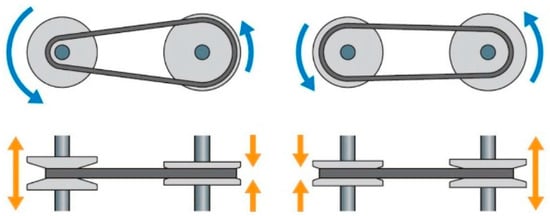
Figure 1
Open AccessArticle
Impact Assessment of Electric Bus Charging on a Real-Life Distribution Feeder Using GIS-Integrated Power Utility Data: A Case Study in Brazil
by
Camila dos Anjos Fantin, Fillipe Matos de Vasconcelos, Carolina Gonçalves Pardini, Felipe Proença de Albuquerque, Marco Esteban Rivera Abarca and Jakson Paulo Bonaldo
World Electr. Veh. J. 2025, 16(11), 621; https://doi.org/10.3390/wevj16110621 - 14 Nov 2025
Abstract
The electrification of public transport with battery electric buses (BEBs) poses technical, regulatory, and environmental challenges. This paper analyzes the impact of BEB charging on a Brazilian urban medium-voltage (MV) feeder using a novel methodology to convert utility GIS data into OpenDSS simulation
[...] Read more.
The electrification of public transport with battery electric buses (BEBs) poses technical, regulatory, and environmental challenges. This paper analyzes the impact of BEB charging on a Brazilian urban medium-voltage (MV) feeder using a novel methodology to convert utility GIS data into OpenDSS simulation models. The study utilizes Geographic Database of the Distribution Company (BDGD) data from the Brazilian Electricity Regulatory Agency (ANEEL) and OpenDSS simulations. Motivated by Cuiabá’s proposal to electrify its public bus fleet, four realistic scenarios were simulated, incorporating distributed photovoltaic (PV) generation and vehicle-to-grid (V2G) operation. Results show that up to 118 BEBs can be charged simultaneously without voltage violations. However, thermal overload occurs beyond 56 units, requiring conductor upgrades or load redistribution. PV systems can supply up to 64% of the daily energy demand but introduce reverse power flows and overvoltages, indicating the need for dynamic control. V2G operation enables peak shaving but also leads to overvoltages when more than 33 buses inject power concurrently. The findings suggest that while the current infrastructure partially supports fleet electrification, future scalability depends on integrating smart grid features and reinforcing the system. Although focused on Cuiabá, the methodology offers a replicable approach for low-carbon urban mobility planning in similar developing regions.
Full article
(This article belongs to the Special Issue Electric Vehicles in Smart Grids: Integration, Optimization, and Sustainability)
►▼
Show Figures

Figure 1
Open AccessArticle
An Efficient Drowsiness Detection Framework for Improving Driver Safety Through Supervised Learning Models
by
Hassan Harb
World Electr. Veh. J. 2025, 16(11), 620; https://doi.org/10.3390/wevj16110620 - 13 Nov 2025
Abstract
Nowadays, we live in the smart mobility era in which vehicles are equipped with small sensing devices to collect various road information. With such sensors, we are able to provide an overview of what is happening on the road and offer an efficient
[...] Read more.
Nowadays, we live in the smart mobility era in which vehicles are equipped with small sensing devices to collect various road information. With such sensors, we are able to provide an overview of what is happening on the road and offer an efficient solution for transport problems such as congestion, accidents, avoiding traffic lights, fuel consumption, etc. Particularly, driver drowsiness is one of the most important problems that transportation systems face and mostly leads to severe accidents, injuries, and deaths. In order to overcome such a problem, a set of sensor devices has been integrated into vehicles to monitor driver and driving behaviors, and then to evaluate the driver’s situation, e.g., drowsy or awake. Unfortunately, most of the proposed drowsiness detection techniques are dedicated to analyzing one behavior type, but not both, which may affect the accuracy rate of the detection. In this paper, we propose an efficient drowsiness detection framework (RDDF) that may analyze one behavior or be adapted to both of them in order to increase the accuracy of drowsiness detection. Mainly, RDDF periodically monitors the driver and driving behaviors, extracts important patterns, and then uses and compares a set of supervised learning models to detect drowsy drivers. After that, RDDF proposes a modified version of the K-nearest neighbors (KNN) model called Jaccard-KNN (JKNN) that increases drowsiness detection accuracy and overcomes several challenges imposed by traditional models. The proposed framework has been preliminarily validated through real sensor data, and we show the effectiveness of our framework in detecting real-time drowsy drivers with an accuracy rate of up to
(This article belongs to the Special Issue Recent Advances in Intelligent Vehicle)
►▼
Show Figures

Figure 1
Open AccessArticle
A Novel Model Chain for Analysing the Performance of Vehicle Integrated Photovoltaic (VIPV) Systems
by
Hamid Samadi, Guido Ala, Miguel Centeno Brito, Marzia Traverso, Silvia Licciardi, Pietro Romano and Fabio Viola
World Electr. Veh. J. 2025, 16(11), 619; https://doi.org/10.3390/wevj16110619 - 13 Nov 2025
Abstract
This study proposes a novel framework for analyzing Vehicle-Integrated Photovoltaic (VIPV) systems, integrating optical, thermal, and electrical models. The model modifies existing fixed PV methodologies for VIPV applications to assess received irradiance, PV module temperature, and energy production, and is available as an
[...] Read more.
This study proposes a novel framework for analyzing Vehicle-Integrated Photovoltaic (VIPV) systems, integrating optical, thermal, and electrical models. The model modifies existing fixed PV methodologies for VIPV applications to assess received irradiance, PV module temperature, and energy production, and is available as an open-source MATLAB tool (VIPVLIB) enabling simulations via a smartphone. A key innovation is the integration of meteorological data and real-time driving, dynamically updating vehicle position and orientation every second. Different time resolutions were explored to balance accuracy and computational efficiency for optical model, while the thermal model, enhanced by vehicle speed, wind effects, and thermal inertia, improved temperature and power predictions. Validation on a minibus operating within the University of Palermo campus confirmed the applicability of the proposed framework. The roof received 45–47% of total annual irradiation, and the total yearly energy yield reached about 4.3 MWh/Year for crystalline-silicon, 3.7 MWh/Year for CdTe, and 3.1 MWh/Year for CIGS, with the roof alone producing up to 2.1 MWh/Year (c-Si). Under hourly operation, the generated solar energy was sufficient to fully meet daily demand from April to August, while during continuous operation it supplied up to 60% of total consumption. The corresponding CO2-emission reduction ranged from about 3.5 ton/Year for internal-combustion vehicles to around 2 ton/Year for electric ones. The framework provides a structured, data-driven approach for VIPV analysis, capable of simulating dynamic optical, thermal, and electrical behaviors under actual driving conditions. Its modular architecture ensures both immediate applicability and long-term adaptability, serving as a solid foundation for advanced VIPV design, fleet-scale optimization, and sustainability-oriented policy assessment.
Full article
(This article belongs to the Section Energy Supply and Sustainability)
►▼
Show Figures

Figure 1
Open AccessArticle
Comprehensive Analysis of Stakeholder Dynamics for Strategic Electric Bus Adoption in Public Transit Networks
by
Thisaiveerasingam Thilakshan, Thusitha Sugathapala, Saman Bandara and Dilum Dissanayake
World Electr. Veh. J. 2025, 16(11), 618; https://doi.org/10.3390/wevj16110618 - 12 Nov 2025
Abstract
Cities are increasingly using electric buses as a viable alternative to diesel buses. This is a crucial undertaking to achieve sustainability in the transport sector. However, integrating them in transport systems in developing countries such as Sri Lanka, which is characterized by environmental
[...] Read more.
Cities are increasingly using electric buses as a viable alternative to diesel buses. This is a crucial undertaking to achieve sustainability in the transport sector. However, integrating them in transport systems in developing countries such as Sri Lanka, which is characterized by environmental and economic challenges, is complex. This work examines the factors that influence the shift from diesel to electric buses with particular attention to the stakeholders, their motivations, and how they seek to achieve their objectives regarding each other, both conflicting and cooperative angles. This study adopts a comprehensive stakeholder-centric methodology to analyze electric bus adoption in the public transit system in Sri Lanka. The research employs a mixed-methods approach that combines qualitative stakeholder analysis with quantitative barrier prioritization, following established project management principles. Based on the case study of Sri Lanka, the research investigates how the electric bus transition can be expedited by leveraging such alliances while considering local challenges like infrastructural deficits, policy gaps, and funding limitations. Lessons learned and best practices from international case studies are considered to provide strategic recommendations to policymakers and other stakeholders to promote the electric bus. By mapping out the interactions between various stakeholders and outlining where key leverage exists, the research provides a roadmap for introducing electric buses. This will be aligned with the sustainability targets and the vision to deliver sustainability goals for the long term.
Full article
(This article belongs to the Special Issue Zero Emission Buses for Public Transport)
►▼
Show Figures

Figure 1
Open AccessArticle
Fault Diagnosis Method of Four-Level Converter Based on Improved Dual-Kernel Extreme Learning Machine
by
Ning Xie, Duotong Yang, Xiaohui Cao and Zhenglei Wang
World Electr. Veh. J. 2025, 16(11), 617; https://doi.org/10.3390/wevj16110617 - 12 Nov 2025
Abstract
To ensure the reliable operation of power converters and prevent catastrophic failures, this paper proposes a novel online fault diagnosis strategy for a four-level converter. The core of this strategy is an optimized multi-kernel extreme learning machine model. Specifically, the model extracts multi-scale
[...] Read more.
To ensure the reliable operation of power converters and prevent catastrophic failures, this paper proposes a novel online fault diagnosis strategy for a four-level converter. The core of this strategy is an optimized multi-kernel extreme learning machine model. Specifically, the model extracts multi-scale features from three-phase output currents by combining Gaussian and polynomial kernels and employs particle swarm optimization to determine the optimal kernel fusion scheme. Experimental validation was performed on an online diagnosis platform for a four-level converter. The results show that the proposed method achieves a high diagnostic accuracy of 99.35% for open-circuit faults. Compared to conventional methods, this strategy significantly enhances diagnostic speed and accuracy through its optimized multi-kernel mechanism.
Full article
(This article belongs to the Section Power Electronics Components)
►▼
Show Figures

Figure 1
Open AccessSystematic Review
Consensus on the Internet of Vehicles: A Systematic Literature Review
by
Hilda Jemutai Bitok, Mingzhong Wang and Dennis Desmond
World Electr. Veh. J. 2025, 16(11), 616; https://doi.org/10.3390/wevj16110616 - 11 Nov 2025
Abstract
►▼
Show Figures
The Internet of Vehicles (IoV) revolutionizes transportation by enabling real-time communication and data exchange among vehicles (V2V), infrastructure (V2I), and other entities (V2X). These capabilities are crucial for improving road safety and traffic efficiency. However, achieving reliable and secure consensus across network nodes
[...] Read more.
The Internet of Vehicles (IoV) revolutionizes transportation by enabling real-time communication and data exchange among vehicles (V2V), infrastructure (V2I), and other entities (V2X). These capabilities are crucial for improving road safety and traffic efficiency. However, achieving reliable and secure consensus across network nodes remains a significant challenge. Consensus mechanisms are essential in IoV for ensuring agreement on the network’s state, enabling applications such as autonomous driving, traffic management, and emergency response. This paper presents a systematic review of IoV consensus mechanisms, examining 78 peer-reviewed publications from 2010 to June 2025 using the PRISMA framework. Our analysis highlights challenges, including scalability, latency, and energy efficiency and identifies trends such as the adoption of lightweight algorithms, edge computing, and AI-assisted techniques. Unlike previous reviews, this work introduces a structured comparative framework specifically designed for IoV environments, enabling a detailed evaluation of consensus mechanisms across key features such as latency, fault tolerance, communication overhead and scalability to identify their relative strengths and limitations.
Full article

Figure 1
Open AccessArticle
Dynamic Horizon-Based Energy Management for PEVs Considering Battery Degradation in Grid-Connected Microgrid Applications
by
Junyi Zheng, Qian Tao, Qinran Hu and Muhammad Humayun
World Electr. Veh. J. 2025, 16(11), 615; https://doi.org/10.3390/wevj16110615 - 11 Nov 2025
Abstract
The growing integration of plug-in electric vehicles (PEVs) into microgrids presents both challenges and opportunities, particularly through vehicle-to-grid (V2G) services. This paper proposes a dynamic horizon optimization (DHO) framework with adaptive pricing for real-time scheduling of PEVs in a renewable-powered microgrid. The system
[...] Read more.
The growing integration of plug-in electric vehicles (PEVs) into microgrids presents both challenges and opportunities, particularly through vehicle-to-grid (V2G) services. This paper proposes a dynamic horizon optimization (DHO) framework with adaptive pricing for real-time scheduling of PEVs in a renewable-powered microgrid. The system integrates solar and wind energy, V2G capabilities, and time-of-use (ToU) tariffs. The DHO strategy dynamically adjusts control horizons based on forecasted load, generation, and electricity prices, while considering battery health. A PEV-specific pricing scheme couples ToU tariffs with system marginal prices. Case studies on a microgrid with four heterogeneous EV charging stations show that the proposed method reduces peak load by 23.5%, lowers charging cost by 12.6%, and increases average final SoC by 12.5%. Additionally, it achieves a 6.2% reduction in carbon emissions and enables V2G revenue while considering battery longevity.
Full article
(This article belongs to the Special Issue Smart Charging Strategies for Plug-In Electric Vehicles)
►▼
Show Figures

Figure 1
Open AccessArticle
Advanced Fault Classification in Induction Motors for Electric Vehicles Using A Stacking Ensemble Learning Approach
by
Said Benkaihoul, Saad Khadar, Yildirim Özüpak, Emrah Aslan, Mishari Metab Almalki and Mahmoud A. Mossa
World Electr. Veh. J. 2025, 16(11), 614; https://doi.org/10.3390/wevj16110614 - 9 Nov 2025
Abstract
This study proposes an innovative stacking ensemble learning framework for classifying faults in induction motors utilized in Electric Vehicles (EVs). Employing a comprehensive dataset comprising motor data, such as speed, torque, current, and voltage, the analysis encompasses six distinct conditions: normal operating mode,
[...] Read more.
This study proposes an innovative stacking ensemble learning framework for classifying faults in induction motors utilized in Electric Vehicles (EVs). Employing a comprehensive dataset comprising motor data, such as speed, torque, current, and voltage, the analysis encompasses six distinct conditions: normal operating mode, over-voltage fault, under-voltage fault, overloading fault, phase-to-phase fault, and phase-to-ground fault. The proposed model integrates Gradient Boosting (GB), K-Nearest Neighbors (KNN), Gradient Boosting (XGBoost), Support Vector Machine (SVM), Decision Tree (DT), and Random Forest (RF) algorithms in a synergistic manner. The findings reveal that the RF–GB–DT–XGBoost combination achieves a remarkable accuracy of 98.53%, significantly surpassing other methods reported in the literature. Performance is evaluated through metrics including accuracy, precision, sensitivity, and F1-score, with results analyzed in comparison to practical applications and existing studies. Validated with real-world data, this study demonstrates that the proposed model offers a groundbreaking solution for predictive maintenance systems in the EV industry, exhibiting high generalization capacity despite complex operating conditions. This approach holds transformative potential for both academic research and industrial applications. The dataset used in this study was generated using a MATLAB 2018/Simulink-based Variable Frequency Drive (VFD) model that emulates real-world EV operating conditions rather than relying solely on laboratory data. This ensures that the developed model accurately reflects practical electric vehicle environments.
Full article
(This article belongs to the Special Issue Dynamic Modeling, Identification, and Advanced Control of Intelligent Electric Vehicles)
►▼
Show Figures

Figure 1
Open AccessArticle
Comprehensive DEA-Based Evaluation of Charging Station Operational Efficiency
by
Jinyu Wang, Houzhi Li, Yang Hu, Jiejin Yan, Chunhua Jin, Zhuowen Zhang and Zhen Yang
World Electr. Veh. J. 2025, 16(11), 613; https://doi.org/10.3390/wevj16110613 - 9 Nov 2025
Abstract
►▼
Show Figures
This study aims to evaluate the operational efficiency of electric vehicle (EV) charging stations and explore optimization strategies to enhance resource utilization and service performance. A systematic review approach was first applied to identify the main evaluation indicators and influencing factors from existing
[...] Read more.
This study aims to evaluate the operational efficiency of electric vehicle (EV) charging stations and explore optimization strategies to enhance resource utilization and service performance. A systematic review approach was first applied to identify the main evaluation indicators and influencing factors from existing studies. Subsequently, a super-efficiency Data Envelopment Analysis (DEA) model was used to assess the efficiency of six EV charging stations in a certain City, China. The robustness analysis was carried out, and the output variables were replaced, and the evaluation results did not change. The results show substantial disparities in efficiency across stations: C1 exhibits the highest operational efficiency, while C3 performs the lowest. The inefficiencies primarily result from supply–demand mismatches and redundant capacity investment. Based on these findings, the study proposes both overall and localized optimization strategies to improve operational performance. The results provide valuable insights for urban energy infrastructure planning and contribute to the enhancement of high-quality, low-carbon transportation development in China.
Full article
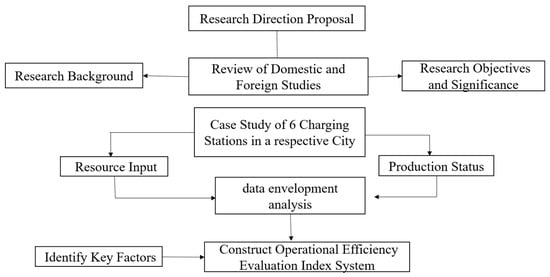
Figure 1
Open AccessArticle
Adaptive Large Neighborhood Search for a Flexible Truck–Drone Routing Problem with Multi-Visit and Cost Trade-Offs
by
Jiang Bian, Rui Zhou and Qingbin Meng
World Electr. Veh. J. 2025, 16(11), 612; https://doi.org/10.3390/wevj16110612 - 7 Nov 2025
Abstract
Extending the truck–drone mothership system, this paper addresses a flexible multi-visit truck and drone joint routing problem (FMTDJRP). A mixed integer linear program is proposed to minimize total travel cost. An adaptive large neighborhood search with a knowledge-based acceleration strategy yields near-optimal solutions.
[...] Read more.
Extending the truck–drone mothership system, this paper addresses a flexible multi-visit truck and drone joint routing problem (FMTDJRP). A mixed integer linear program is proposed to minimize total travel cost. An adaptive large neighborhood search with a knowledge-based acceleration strategy yields near-optimal solutions. Experiments across varied customer distributions, drone specs, and truck-–drone cost ratios confirm flexibility, adaptability, and cost efficiency.
Full article
(This article belongs to the Special Issue Changes in Travel Behavior When Autonomous Vehicles Are Integrated into the Existing Transport System in Urban Cities)
►▼
Show Figures
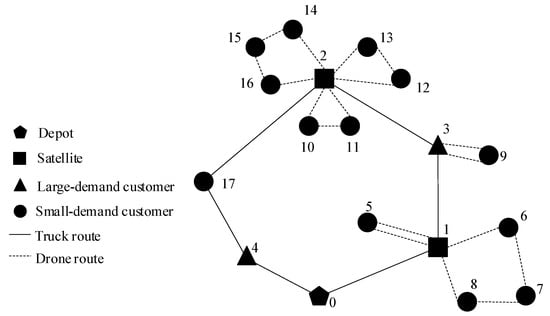
Figure 1
Open AccessReview
Application of Psychoacoustic Metrics in the Noise Assessment of Geared Drives
by
Krisztian Horvath
World Electr. Veh. J. 2025, 16(11), 611; https://doi.org/10.3390/wevj16110611 - 6 Nov 2025
Abstract
►▼
Show Figures
Psychoacoustic metrics offer a valuable complement to traditional noise evaluation methods for gear transmissions, as they account for the human perception of sound quality rather than relying solely on physical measurements. While parameters such as overall sound pressure level (SPL) and spectral content
[...] Read more.
Psychoacoustic metrics offer a valuable complement to traditional noise evaluation methods for gear transmissions, as they account for the human perception of sound quality rather than relying solely on physical measurements. While parameters such as overall sound pressure level (SPL) and spectral content quantify noise intensity and frequency distribution, they often fail to reflect subjective annoyance caused by tonal or high-frequency components common in gear systems. This review provides a structured overview of how psychoacoustic metrics—including loudness, sharpness, roughness, fluctuation strength, and tonality—are applied in the analysis of gear transmission noise. Relevant studies were identified through a comprehensive search across multiple scientific databases, with 54 meeting the inclusion criteria. The findings highlight both the benefits and limitations of these metrics, and present examples of their industrial application in automotive and mechanical engineering contexts. The review also identifies gaps in current research, particularly in integrating psychoacoustic evaluation with predictive modelling and machine learning, and suggests directions for future work.
Full article

Figure 1
Open AccessArticle
Feasibility Analysis and Optimisation of Vehicle-Integrated Photovoltaic (VIPV) Systems for Sustainable Transportation
by
Mark Smitheram and Ehsan Gatavi
World Electr. Veh. J. 2025, 16(11), 610; https://doi.org/10.3390/wevj16110610 - 6 Nov 2025
Abstract
This paper investigates the feasibility of vehicle-integrated photovoltaic (VIPV) systems for light vehicles by developing and simulating an intelligent solar integration design based on the Tesla Model 3. The proposed system incorporates roof and bonnet-mounted photovoltaic modules, each managed by independent buck converters
[...] Read more.
This paper investigates the feasibility of vehicle-integrated photovoltaic (VIPV) systems for light vehicles by developing and simulating an intelligent solar integration design based on the Tesla Model 3. The proposed system incorporates roof and bonnet-mounted photovoltaic modules, each managed by independent buck converters employing maximum power point tracking (MPPT) for optimal energy extraction. A novel fuzzy logic controller was designed to dynamically allocate auxiliary battery charging between the traction battery and the solar subsystem, using real-time irradiance and state-of-charge (SOC) inputs. The system was implemented in MATLAB/Simulink with location-specific data for Melbourne, Australia. Simulation results demonstrate high converter efficiencies of 94–95%, stable MPPT convergence within 0.5 s and an estimated annual solar contribution of 930 kWh, confirming effective control and energy management under varying conditions. This work highlights the innovative application of adaptive fuzzy control and dual MPPT coordination within VIPV systems and provides a validated basis for future optimisation and real-world integration.
Full article
(This article belongs to the Section Energy Supply and Sustainability)
►▼
Show Figures

Graphical abstract

Journal Menu
► ▼ Journal Menu-
- WEVJ Home
- Aims & Scope
- Editorial Board
- Topical Advisory Panel
- Instructions for Authors
- Special Issues
- Topics
- Sections
- Article Processing Charge
- Indexing & Archiving
- Editor’s Choice Articles
- Most Cited & Viewed
- Journal Statistics
- Journal History
- Journal Awards
- Society Collaborations
- Conferences
- Editorial Office
Journal Browser
► ▼ Journal BrowserHighly Accessed Articles
Latest Books
E-Mail Alert
News
Topics

Conferences
Special Issues
Special Issue in
WEVJ
The Contribution of Electric Vehicles to Realization of Dual Carbon Goal
Guest Editors: Yongxing Wang, Chaoru Lu, Dongfan XieDeadline: 30 November 2025
Special Issue in
WEVJ
Dynamic Modeling, Identification, and Advanced Control of Intelligent Electric Vehicles
Guest Editor: Te ChenDeadline: 30 November 2025
Special Issue in
WEVJ
Recent Advances in Autonomous Vehicles
Guest Editors: Soualmi Boussaad, Duc-Thang NguyenDeadline: 30 November 2025
Special Issue in
WEVJ
Vehicle System Dynamics and Intelligent Control for Electric Vehicles
Guest Editors: Leilei Zhao, Liguo Zang, Yuewei Yu, Jian WangDeadline: 31 December 2025










